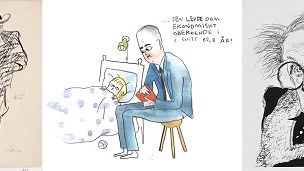
Press release -
Caricature exhibition opens on 8 March
Over the spring and summer, Nationalmuseum is showing The Art of Exaggeration – Caricature in Sweden. The exhibition encapsulates the development of Swedish caricature art, from the private sphere to a public prominence that echoes around the world. On display are around 90 drawings, prints and digital images from the 16th century to the present day.
The key element of a caricature is that it captures the features and body language of a recognisable figure, whether in a humorous situation or not. This means that it may be done in jest, but is not always the case. It makes its point by exaggerating typical and peculiar characteristics, without going too far and turning into bullying and defamation. An elegant cartoon style of drawing takes the sting out of the irony in the image and the humour softens some of the danger and embarrassment.
Caricature can be traced back to the interest in exaggeration that came out of the Baroque style and Mannerism, as well as the focus of science on the correlation between a person’s body and their psyche in the 17th century. It has strong ties with both the physiognomy studies of the art establishment and scientific theorising, but is not ranked highly in the art hierarchy. It often becomes sidelined by the art museums in favour of an artist’s more acclaimed output. A prime example is Johan Tobias Sergel, who is best known as a sculptor, but was also a frequent caricaturist, particularly in his private letters to his friend Carl August Ehrensvärd.
The caricature first became popular in the 17th century, as an art form of a more private nature that appeared in letters and diaries. However, the new printing technologies of the 18th century made mass printing possible and brought the caricature into the public arena. With the growth of the picture press in the 19th century, it became a powerful symbol and being caricatured started to be seen as a sign of celebrity status. Traditionally, caricature was a male preserve, but in the early 20th century women started making a name for themselves, not least as theatre caricaturists. After a golden age in the 20th century as political comment on the editorial pages of the daily newspapers, interest in the caricature tailed off in Sweden towards the end of the century. However, it once again became a burning issue in 2005, when Denmark’s Jyllands-Posten published the cartoons of the prophet Mohammed that prompted such strong reactions around the globe.
The exhibition includes works from the collections of Nationalmuseum and Moderna Museet, with additional material from the National Archives of Sweden, Stockholm Music and Theatre Museum, the Royal Swedish Academy of Fine Arts and university libraries. Contemporary cartoonists are also represented, with caricatures of politicians, celebrities and artists. The exhibition presents around 90 drawings, prints and digital images by Swedish artists from the 16th century to the present day. The artists on display include Johan Tobias Sergel, Carl August Ehrensvärd, Gustaf Wahlbom, Albert Engström, EWK, Annie Bergman and Stina Eidem.
The exhibition runs from 8 March to 12 August in the Gallery on the entrance level, where admission is free.
Further information
Lena Johannesson, exhibition curator, johannesson.lena@gmail.com, +46 704 22 45 32 (private number)
Ulf Cederlöf, exhibition curator, ulf.cederlof@nationalmuseum.se, +46 8 5195 4402
Hanna Tottmar, press officer, hanna.tottmar@nationalmuseum.se, +46 8 5195 4390, +46 767 23 46 32
Press images
www.nationalmuseum.se/pressroom
Captions
Knut Stangenberg, Anders Zorn, © Nationalmuseum; Emma Adbåde, Fredrik Reinfeldt reads a bedtime story, © Emma Adbåde; Ulf Sveningson, Ingrid Segerstedt-Wiberg, © Ulf Sveningson
Categories

